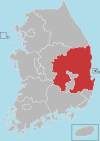
Yeongju is a city in the far north region of North Gyeongsang province in South Korea, covering 668.84 km2 with a population of 113,930 people according to the 2008 census. The city borders Bonghwa county to the east, Danyang county of North Chungcheong province to the west, Andong city and Yecheon county to the south, and Yeongwol county of Gangwon province to the north.

Danyang County is in North Chungcheong Province, South Korea.

Boeun County (Boeun-gun) is a county in North Chungcheong Province, South Korea.
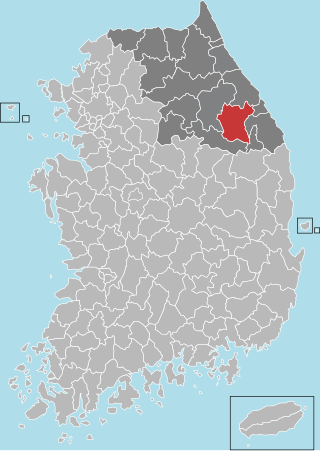
Jeongseon (Jeongseon-gun) is a county in the province of Gangwon-do, South Korea. It is famous as the hometown of "Jeongseon Arirang," a traditional Korean folksong. It is also the hometown of actor Won Bin and footballer Seol Ki-hyeon.

Damyang County (Damyang-gun) is a county in Jeollanam-do, South Korea. Tourism is a major local industry. Notable local products include bamboo goods and strawberries.

Buan County (Buan-gun) is a county in Jeonbuk Sate, South Korea. It is bounded by the city of Jeongeup on the east, the county of Gochang on the south, the city of Gimje on the north, and Yellow Sea on the west. Buan is divided into 1 eup, 12 myeon, and 510 ri. Buan had a 2001 estimated population of 74,716 people and a 2018 population of 54,441 people with an area of 493.35 km2. Famous people from Buan include Joseon Dynasty kisaeng and poet, Yi Mae-chang. Like many rural areas in southern Korea, it has seen shrinking population with many younger people moving north to larger cities such as Seoul. This county should not be confused with Muan, the new capital of South Jeolla Province.

Namyangju is a city in Gyeonggi Province, South Korea. To the east is Gapyeong County, to the west is Guri City, and to the north is Pocheon City. Namyangju-si was originally a southern part of Yangju-gun, but was separated into Namyangju-gun in April 1980. In 1995, Migeum-si and Namyangju-gun were merged to form an urban and rural complex. The city hall is located in Geumgok-dong and Dasan-dong, and the administrative districts are 6-eup, 3-myeon, and 7-dong.

Seocheon County is a county in Chungcheongnam-do, South Korea. It is famous for its seafood and location near the mouth of the Geum River.
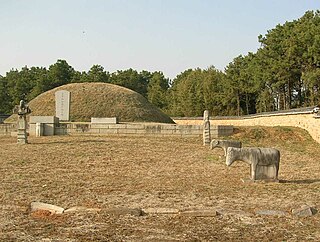
Sangju is a city in North Gyeongsang Province, central South Korea. Although Sangju is rather rural, it is very old and was once a key city. Along with Gyeongju, it gives rise to half of the name of the Gyeongsang provinces. Sangju is nicknamed Sam Baek, or "Three Whites", referring to three prominent agricultural products rice, silkworm cocoons, and dried persimmons from the area.

Bonghwa County (Bonghwa-gun) is a county in North Gyeongsang Province, South Korea. It lies inland, at the northern edge of the province, and borders Gangwon province to the north. To the east it is bounded by Yeongyang and Uljin counties, to the south by Andong, and to the west by Yeongju. The county is ringed by the Taebaek and Sobaek Mountains, the highest of which is Taebaeksan (1,566.7m). Because of its mountainous location, Bonghwa has a colder climate than most of the province, with an average annual temperature of 10 °C (50 °F).

Cheongdo County (Cheongdo-gun) is a county in North Gyeongsang Province, South Korea. It is connected to the national transportation grid by the Gyeongbu Line railroad and the Daegu-Busan Expressway. The seat of government is located in the center of the county, in Hwayang-eup.

Gunwi County (Gunwi-gun) is a county in Daegu Metropolitan City, South Korea.

Uljin County is a county in North Gyeongsang Province, South Korea. Before 1963, Uljin was in Gangwon Province.
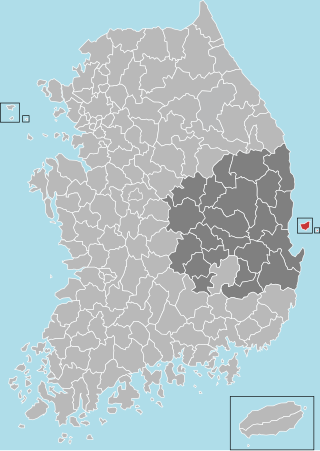
Ulleung County is a county in North Gyeongsang Province, South Korea.

Yecheon County is a county in the province of North Gyeongsang, South Korea. It is 661 km2 in area, and in 2004 had a population of 52,311. It has lost over 2/3 of its inhabitants since the mid-1960s. It consists of twelve administrative districts. The county borders Yeongju city to the northeast, Andong city to the east, Uiseong county to the southeast, Mungyeong city to the west, Sangju city to the southwest, and Danyang county of North Chungcheong province to the northwest.
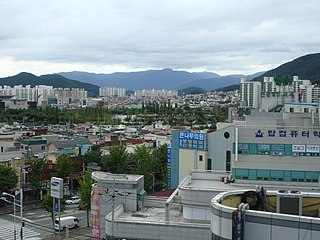
Gimhae is a city in South Gyeongsang Province, South Korea, situated near the Nakdong River.
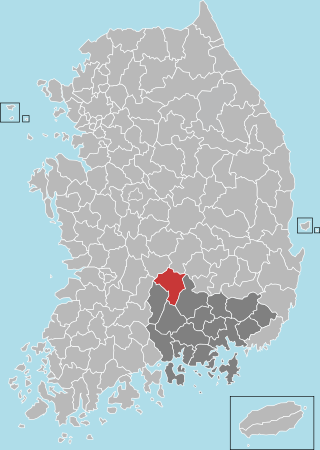
Geochang County is a county in South Gyeongsang Province, South Korea. The Geochang International Festival of Theater, which was started in 1989, is renowned as the best play festival in Korea. The District Office is located in Geochang-eup, and has jurisdiction over 1 eup and 11 myeon.
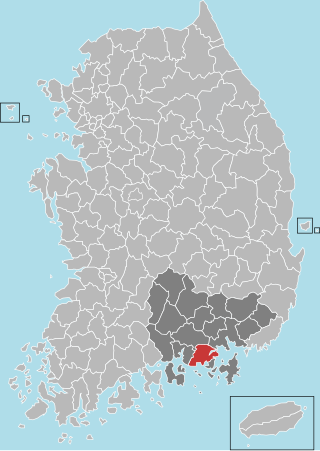
Goseong County (Goseong-gun) is a county in South Gyeongsang Province, South Korea
Geumseong-myeon is a myeon in Uiseong, South Korea. It is well known for Uiseong garlic and Tap-ri dinosaur/dinosaur fossil.
Daegwallyeong-myeon is a myeon (township) in the county of Pyeongchang in the province of Gangwon-do, South Korea. It is located in the northeastern part of the county. The total area of Daegwallyeong-myeon is 221.63 square kilometers (85.57 sq mi), and, as of 2008, the population was 6,162 people. The myeon was named Doam-myeon until 2007. Daegwallyeong-myeon is named after the important mountain pass of Daegwallyeong. It has the coldest average temperature in South Korea.
























